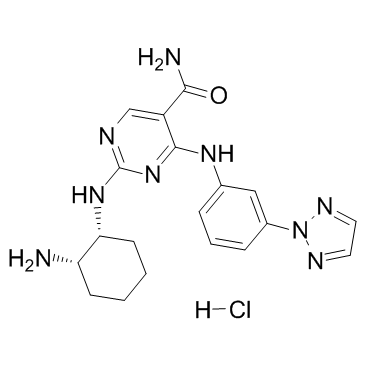1370261-97-4
| Name | 2-{[(1R,2R)-2-Aminocyclohexyl]amino}-4-{[3-(2H-1,2,3-triazol-2-yl )phenyl]amino}-5-pyrimidinecarboxamide hydrochloride (1:1) |
|---|---|
| Synonyms |
2-[[(1R,2S)-2-Aminocyclohexyl]amino]-4-[[3-(2H-1,2,3-triazol-2-yl)phenyl]amino]-5-pyrimidinecarboxamide Hydrochloride
Benzonitrile,4-(3-[1,1'-biphenyl]-4-yl-3-oxopropyl) 4-(3-(2H-1,2,3-triazol-2-yl)phenylamino)-2-((1R,2S)-2-aminocyclohexylamino)pyrimidin-5-carboxamide hydrochloride 4-(3-([1,1'-biphenyl-4-yl])-3-oxopropyl)benzonitrile 2-{[(1R,2S)-2-Aminocyclohexyl]amino}-4-{[3-(2H-1,2,3-triazol-2-yl)phenyl]amino}-5-pyrimidinecarboxamide hydrochloride (1:1) 5-Pyrimidinecarboxamide, 2-[[(1R,2S)-2-aminocyclohexyl]amino]-4-[[3-(2H-1,2,3-triazol-2-yl)phenyl]amino]-, hydrochloride (1:1) PRT062607 HCI P505-15 BIIB057 PRT062607 Hydrochloride |
| Description | PRT062607 hydrochloride is a highly specific and potent inhibitor of purified Syk (IC50 1-2 nM). |
|---|---|
| Related Catalog | |
| Target |
IC50: 1 nM (Syk), 81 nM (Fgr), 88 nM (MLK1), 123 nM (Yes)[1] |
| In Vitro | PRT062607 (P505-15) Hydrochloride is a novel, highly specific, and potent orally available small-molecule inhibitor of Syk. The potency of PRT062607 against its target kinase Syk is initially tested in two different purified kinase assays. Using a FRET assay, half-maximal Syk inhibition required 6±0.2 nM (mean±S.E.M.). Similar potency is observed when tested in a radioactive enzyme assay, with a resulting Syk IC50 of 2.1±0.4 nM (mean±S.E.M.). In human whole blood, PRT062607 potently inhibits B cell antigen receptor-mediated B cell signaling and activation (IC50 0.27 and 0.28 μM, respectively) and Fcε receptor 1-mediated basophil degranulation (IC50 0.15 μM)[1]. |
| In Vivo | In the mouse CAIA model, oral administration of PRT062607 (P505-15) results in an average inhibition of paw inflammation, as measured by daily scoring of inflammation compared with vehicle controls, of 12, 44, and 87% with average plasma concentration (C average over 24 h) assessed at the end of the study of 0.38, 0.95, and 1.47 μM, respectively. In mice treated with 30 mg/kg PRT062607, the damage to the joints is significantly reduced and seemed indistinguishable from normal mice. In the rat CIA model, the high dose of PRT062607 (15 mg/kg b.i.d.) completely suppresses inflammation in a majority of the animals (seven of eight), by the end of the study (mean inflammation score±S.E.M.=0.63±1.1; p<0.0001 versus vehicle)[1]. |
| Kinase Assay | Potency of Syk inhibition is determined by using a fluorescence resonance energy transfer (FRET) assay. The extent of substrate phosphorylation by Syk is measured in the presence of various PRT062607 (P505-15) concentrations. Syk activity is determined by a fluorescent antibody specific for phosphorylated tyrosine by using the increase of FRET. Twelve concentrations are tested for dose response. Specificity and potency of kinase inhibition is determined by evaluation of PRT062607 in the Kinase Profiler panel of 270 independent purified kinase assays. For profiling, PRT062607 is tested in duplicate at two concentrations at a fixed concentration of ATP. Subsequently, IC50 determinations using the radioactive assays are carried out at an ATP concentration optimized for each individual kinase. All radioactive ATP incorporation enzyme assays are performed[1]. |
| Cell Assay | SUDHL4 cells (106 cells) are stimulated for 30 min with F(ab)′2 anti-human IgM antibody. Signaling is terminated by resuspending cells in ice-cold lysis buffer (50 mM Tris, pH 7.4, 150 mM NaCl, 0.5 mM EDTA, 1% nonidet P-40, and 0.5% sodium deoxycholate) containing freshly added protease and phosphatase inhibitor tablets. Protein lysates are resolved by SDS-polyacrylamide gel electrophoresis under reducing conditions and probed with the indicated antibodies. Secondary antibody conjugated to horseradish peroxidase and enhanced chemiluminescence detection reagent are used for the detection of specific protein. Where indicated, cells are pretreated for 1 h at 37°C with PRT062607 or vehicle control before stimulation. Densitometry of exposed films is performed by using the AlphaImager 2200. Ba/F3 cells are seeded at 5000 cells per well in a 384-well tissue culture plate containing media with various concentrations of PRT062607 or staurosporin. After 3 days, viability of cells is quantitated by CellTiter Glo following the manufacturer-supplied protocols[1]. |
| Animal Admin | Mice[1] Female BALB/c mice receive a single oral dose of 15 or 30 mg/kg PRT062607 and are anesthetized with a subcutaneous ketamine cocktail, and blood is harvested via cardiac puncture at 0.5, 1, 2, 3, 4, 5, 6, 8, and 24 h postdose, (n=3/time point; n=8 vehicle controls). Blood is dispensed into three heparin-containing tubes, one for determination of drug concentration and the remaining two for ex vivo stimulation with isotype control or anti-mouse IgD antibody for 10 min. Blood is processed for intracellular phospho-flow cytometry to evaluate BCR signaling as described earlier; mouse B cells are detected by using CD45R-B220 PerCP-conjugated antibody. Plasma samples are analyzed for PRT062607 concentration by using a liquid chromatography tandem mass spectrometer. The analytical range is 2 to 5000 ng/mL. Rats[1] Collagen-induced arthritis (CIA) is induced in female, 7-week old Lewis rats by subcutaneous injection of bovine collagen II emulsified with incomplete Freund's adjuvant at the base of the tail. On day 10, the rats are boosted with a second subcutaneous injection. PRT062607 administration is initiated when at least one hind paw is inflamed (inflammation score 1), and enrollment into a treatment group is designated as day 1 of the study for each individual animal (n=8/dose group). Progression of disease is evidenced by increased edema and erythema of one or both ankle joints, followed by the involvement of the metatarsal and interphalangeal joints. Fully developed arthritis is observed approximately 4 to 7 days after the onset of inflammation. Hind paws (sum of two paws) are scored daily for progression of inflammation. Inflammation scores for each paw are determined based on the following scale: 0, normal; 1, mild, but definite redness and swelling of the ankle possibly limited to individual digits; 2, moderate redness and swelling of ankle; 3, severe redness and swelling of the entire paw including digits; and 4, maximally inflamed limb with involvement of multiple joints. Ankle thickness measurements are obtained by a caliper device. At study termination, rats are anesthetized, and blood is harvested by cardiac puncture for complete blood counts and drug plasma concentration. |
| References |
| Molecular Formula | C19H24ClN9O |
|---|---|
| Molecular Weight | 429.907 |
| Exact Mass | 429.179230 |
| PSA | 153.88000 |
| LogP | 3.46300 |
| Hazard Codes | Xi |
|---|

